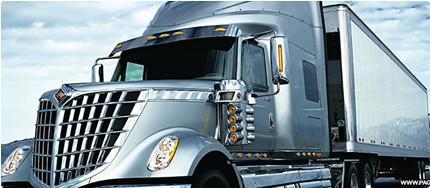Review Questions - Click On The Picture To Begin...

- If belt driven, check to make sure the belt is tight and free of excessive wear
- Check it with the engine running and make sure the alternator gets warm
- Be sure there are no leaks
- Check the oil level in the alternator
Quote From The CDL Manual:
Check belts for tightness and excessive wear (alternator, water pump, air compressor)-learn how much "give" the belts should have when adjusted right, and check each one.
- Hazards to vehicle movement (people, other vehicles, objects, low hanging wires, limbs, etc.)
- All of these answers are correct
- Vehicle damage or leaning to one side
- Fresh oil, coolant, grease or fuel leaks
Quote From The CDL Manual:
Approaching the vehicle: Notice its general condition. Look for damage or vehicle leaning to one side. Look under the vehicle for fresh oil, coolant, grease or fuel leaks. Check the area around the vehicle for hazards to vehicle movement (people, other vehicles, objects, low hanging wires, limbs, etc.).
TruckingTruth's Advice:
Sometimes, being close up to a vehicle can force you to miss some obvious hazards. Take a moment to get the "full picture" when walking up to your vehicle.
- All of these may be belt driven
- Turbo
- Water pump
- Camshaft
Quote From The CDL Manual:
Check belts for tightness and excessive wear (alternator, water pump, air compressor)-learn how much "give" the belts should have when adjusted right, and check each one.
TruckingTruth's Advice:
When checking any belts, be sure they aren't frayed, cracked, or broken.







 TT On Facebook
TT On Facebook